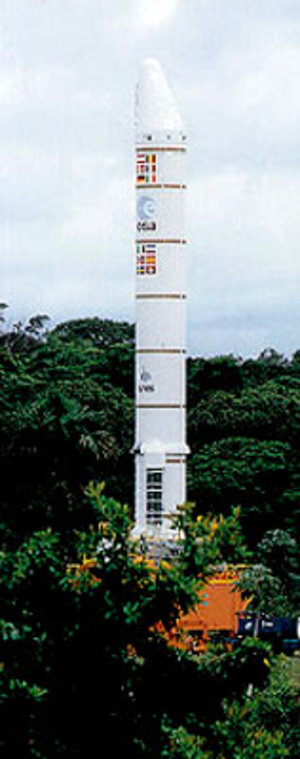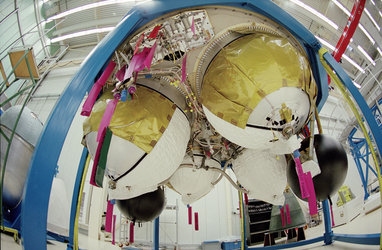Ariane 5 fairing
The Ariane 5 rocket fairing was positioned on the very top of the launcher. Its function was to protect the payload against aerodynamic, thermal and acoustic phenomena as the launcher rose from the launch pad through the atmosphere to an altitude of approximately 100 km.
Once the launcher left Earth’s atmosphere, approximately three minutes after liftoff, the fairing was jettisoned. This lightened the remaining launcher’s load as it lost approximately two tonnes of this no-longer required structure.
The configurations of the fairing were developed and qualified to fit the requirements of the satellite market to accommodate dual-launch missions. It was conical in shape and consisted of two half shells connected by a vertical separation system. Externally it was made of carbon-covered aluminium honeycomb panels of variable thickness. These are light but sufficiently rigid to withstand atmospheric pressure during ascent.
On the inside, the fairing was originally covered with acoustic absorption panels, designed to counter noise levels in the structure at liftoff, particularly the noise from the solid rocket boosters. In 2004 this acoustic protection was removed as tests carried out during satellite environment qualification showed that it was no longer necessary.
A double pyrotechnic system was used to separate the fairing. A vertical separation system split the fairing in two when it separates from the launcher by the means of a pyrotechnic cord incorporated into one side of the shell edge. When this detonated, a flexible fully-sealed sleeve pushed the other half of the shell away.
This operation was closely coordinated with the horizontal separation system. By detonating a pyrotechnic charge, the horizontal aluminium connecting frame ruptured at its weakest point and freed the fairing.
Responsible contractor: Oerlikon-Contraves AG(Switzerland)















 Germany
Germany
 Austria
Austria
 Belgium
Belgium
 Denmark
Denmark
 Spain
Spain
 Estonia
Estonia
 Finland
Finland
 France
France
 Greece
Greece
 Hungary
Hungary
 Ireland
Ireland
 Italy
Italy
 Luxembourg
Luxembourg
 Norway
Norway
 The Netherlands
The Netherlands
 Poland
Poland
 Portugal
Portugal
 Czechia
Czechia
 Romania
Romania
 United Kingdom
United Kingdom
 Slovenia
Slovenia
 Sweden
Sweden
 Switzerland
Switzerland


































